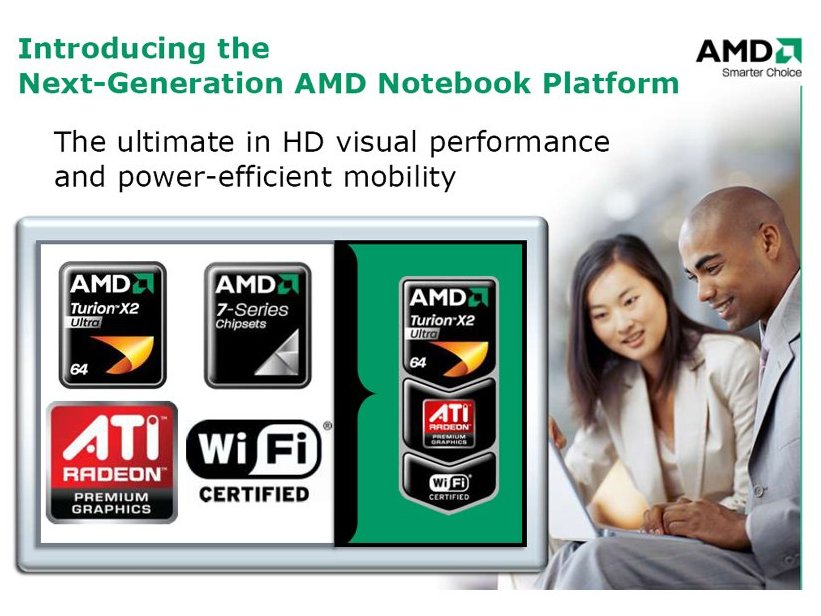AMD sinks teeth into Centrino with Puma platform
Nice graphics, what about the battery life?

It's been an awfully long time coming. But AMD has finally unleashed its latest mobile PC platform, codenamed Puma.
Much like Intel's Centrino technology, Puma draws together a gaggle of components to create a comprehensive mobile platform for laptop PCs. Key features include the revised Turion X2 Ultra processor, the new 7 Series mobile chipset and ATI Mobility Radeon HD 3200 series integrated graphics.
Botched branding?
But unlike Centrino, AMD has not given Puma a single, unifying brand name for punters to latch onto. In fact, it's not clear how the final product should actually be referred to. AMD's documentation describes it rather clumsily as the Next Generation Turion Radeon Platform.
That could be a tough sell against Intel's cleverly-promoted Centrino platform. But if the branding looks a little messy, how does Puma's hardware stack up?
First up is the new Turion X2 Ultra processor. In terms of performance, do not expect any fireworks. The execution cores are carried over from the previous Turion X2 chip and hence remain a generation behind AMD's desktop and server cores.
However, the Turion X2 Ultra's memory controller and HyperTransport links do receive an overhaul, largely with a view to further optimising power consumption.
Are you a pro? Subscribe to our newsletter
Sign up to the TechRadar Pro newsletter to get all the top news, opinion, features and guidance your business needs to succeed!
Multimedia malarkey
Next is the new 780G mobile chipset. The big news here is the new Radeon HD 3200 integrated graphics core complete with support for DirectX 10.1. AMD reckons it's three times as fast as Intel's integrated GPU.
But perhaps even more significantly, it includes a full-featured version of the UVD 2D decode engine. In other words, notebooks based on the Puma platform will be capable of smoothly decoding a full 1080p Blu-ray movie disc without stressing the CPU. In theory, that should translate into much better battery life when viewing HD flicks on the move.
The 780G chipset and and Radeon graphics also enable a slew of further consumer-friendly features. Hybrid CrossFire technology, for instance, will enable the sale of notebooks with both integrated and discreet graphics. While that's nothing new, the fact that users will be able to switch between the two on the fly according to application demand certainly is.
Wireless wonder
The final piece of the puzzle is wireless networking. Here, things become rather confusing. AMD is not in the business of producing wireless radios, so Wi-Fi comes courtesy of a number of third party suppliers. Nevertheless, AMD claims that each and every one of them is superior to Intel's Wi-Fi technology.
Ultimately, therefore, Puma adds up to a more efficient CPU and some serious multimedia clout. If only AMD could address the Puma's branding weakness, the latter could be winning feature in the increasingly media-hungry consumer market.
Tardy Turion
However, that Turion processor does give cause for concern. It already lags behind Intel's Core 2 processors for raw performance. That's only going to get worse as Intel ramps up the availability of its new 45nm mobile chips.
AMD has so far also been unwilling to discuss how the new Puma platform compares with Centrino in terms of battery life. When we pressed AMD's Ian McNaughton on the matter he said that individual metrics such as battery life are not important, “it's the overall experience that matters.”
He also emphasised that notebook designs vary so widely, it was “virtually impossible” to draw general conlusions. “When you get your hands on the hardware, we'll let you make that determination,” McNaughton said.
Better battery life?
Perhaps, but then AMD did manage to have a pair of externally identical MSI laptops on hand, one powered by Puma the other by Centrino. The idea was to demonstrate the performance advantage of the new Radeon HD 3200 graphics core. Surely a battery life comparison of the two systems would have been equally valid?
Whatever the power efficiency of Puma, one thing is for certain. It's a mainstream platform and not designed to compete with Intel's ultra low voltage Centrino products. As McNoughton said, “that's not what Puma is, but we do have near-term products that will address that space.”
As a final note, it's worth remembering that consumer notebook sales already outpace those of desktop PCs. Making a success of Puma would do much to offset AMD's current troubles with the Phenom desktop processor. To that end, AMD needs to sort out Puma's confused branding, pronto.
Technology and cars. Increasingly the twain shall meet. Which is handy, because Jeremy (Twitter) is addicted to both. Long-time tech journalist, former editor of iCar magazine and incumbent car guru for T3 magazine, Jeremy reckons in-car technology is about to go thermonuclear. No, not exploding cars. That would be silly. And dangerous. But rather an explosive period of unprecedented innovation. Enjoy the ride.